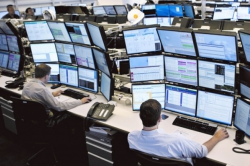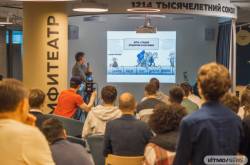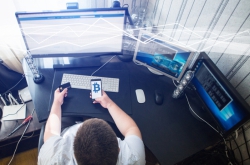Meetup
The meetup started with an introductory speech by Denis Stolyarov - chief engineer at ITMO’s Design and Multimedia Center and founder of the Video360Production small innovative enterprise. It is planned that the Blockchain Campus will also be launched as part of a small innovative enterprise, in the university’s building on Chaikovskogo Street in February. This will be a dedicated platform with some features of an accelerator that will provide both resources and mentorship for blockchain-related projects. Every week, the cluster will host educational courses on both software development in the field of blockchain and such economics issues as cryptocurrency trading. This means that the campus will become a place where both novice and experienced developers will get the opportunity to get valuable advice, meet like-minded people and develop their ideas.
This is exactly why the seventh meetup of St. Petersburg’s biggest blockchain developer community took place at ITMO. The community brings together more than 500 specialists in the field of blockchain technology, economics of cryptocurrencies, banking, and legal regulation. Once a month, its members gather to discuss the field’s relevant problems. From now on, they will actively participate in the work of Blockchain Campus.
“Nowadays, information technologies have become so science-intensive that most people who are interested in them fail to learn to apply them due to the lack of educational events and courses. So, my colleagues and I got the idea to create a community where specialists would get the opportunity to communicate with each other, and novices would be able to get knowledge straight from the source, without the need to resort to the many commercial and promotional sources that often provide incorrect information,” comments Dmitriy Plakhov.

This is how St. Petersburg blockchain community came to be. The community conducts different events for both novices and specialists in the field of blockchain; the 7th meetup, for instance, was intended for students. The organizers expected people who know little about blockchain, so they chose two specific topics and two popular ones that would be more comprehensible to the newcomers.
Thus, the first two presentations were dedicated to random numbers and the problems of developing decentralized applications on Ethereum blockchain. The meetup’s participants also learned about getting tokens for working with smart contracts on the Cryptopus platform that was developed by an ITMO student.
Aleksandr Mazaletskij, founder, head and chief engineer of the Dicoiner blockchain integrator explained why mining and processing of transactions in blockchain systems is so expensive and resource-consuming. For the last two years, Aleksandr, who is a graduate of the Internet Initiatives Development Fund, has been researching the opportunities for launching blockchain systems in the corporate segment.
On smart contracts
How do smart contracts operate within a blockchain system? Let’s say you’ve decided to buy a book via an internet store that accepts cryptocurrency as payment. In order to accept payment from you, the retailer sends you its account number. You, in turn, send a payment request to the system, having authenticated it with your private key. Yet, the payment has to be verified, i.e. made “legal” in this system. In terms of blockchain, this means binding this transaction to all other transactions. This is essential for preventing anyone from counterfeiting information about the transaction: this way, it would be necessary to alter data about every transaction to hack but a single one. To be more specific, that would mean altering the “blocks”.

So, what are these “blocks”? The blocks are based on several transactions, like the one you made to purchase a book. Blocks are created by miners - loosely, those are people who solve certain mathematical tasks to do that, though in reality those are special mining devices, i.e. computers. These processes result in the creation of cryptographic hash; each block contains information on both its own hash and the hash of the previous block. This is how blocks are arranged into the “chain”, which stores data on all verified transactions. After the transaction has been encoded into the block, i.e. became part of the chain, the miners get cryptocurrency as compensation, and you get your book.
Surely, that seems a bit too complicated: why does one even need miners? Why make all those computations? What do they get compensated for? Actually, it’s quite simple. The miners’ main task is to generate the computations that create the cryptographic hash. The hash is necessary in order for the transaction (the purchase) to be recorded in the blockchain system and be bound to other blocks. Yet, that calls for considerable computational capacities and energy. It is the miners who offer these resources, and that is what they get compensated for. In other words, it is their collective effort that provides for blockchain’s viability. Naturally, that could be done by more centralized means, like creating a server powerful enough to make these computations - nowadays, this method is used by some of the large companies that integrate blockchain systems into their domestic business processes.

Blockchain systems are really convenient, as they allow to minimize the expense of resources (both human and economic) on conducting transactions. In future, whole new economies will be built on such systems, where human participation will be brought to a minimum. The simplest example - there will no longer be any use for the services of accountants and attorneys who now check and verify contracts. If everyone in the system knows about a contract, and it is part of a block encoded with cryptographic hash, there would be no point in legalizing by any other means.
This is why now, new companies appear that offer advanced solutions for working with smart contracts, including those for the corporate sector. For instance, Dicoiner now has a framework for creating and launching safe smart contracts for conducting ICOs and releasing new coins.
How much does mining cost.
Still, working with blockchain consumes lots of resources in terms of energy and finances. For instance, decent equipment for mining costs about 170 USD, says Aleksandr Mazaletskij. The device will consume about 1200 kW per hour - the same amount that an electric kettle consumes in two minutes. What is more, the equipment is really noisy. According to Aleksandr, when he had a miner at his house, it was like living next to an airport. If one decides to make use of the services of mining centers, that would be costly, as well - each transaction will cost about 5 USD.

“This is why not everyone becomes a miner - mining is quite costly and troublesome. Still, as of now there’s quite an arms race going on in the field of creating better mining equipment. Also, some people work on solutions that would make it possible to get additional bonuses from the equipments’ operation. For instance, I know that you can buy a grill powered by a mining device’s heat energy on the Internet. What’s more, some even develop mining data centers that can heat whole buildings. I have to say that when I were mining at home myself, I also used my device for heating, that was during the cold time of the year, as I remember,” explains Aleksandr Mazaletskij.
He is sure that soon, new algorithms and devices will appear, those that will allow to use mining equipment to solve many application tasks. That’s not only about heating: such devices will be great for scientists who need high capacities for studying DNA structures, brain mapping and other research. Nowadays, citizen science follows a similar principle, when computer users from all over the world lend part of their capacities to scientists who need them for heavy computing.

So, as it has become almost impossible to mine independently, miners came up with the idea of mining pools. Mining pools are servers that distribute the task of finding blocks amongst all of its members. In other words, it becomes possible to mine together! Yet, the reward is split between the members, as well. Basically, most of today’s mining is conducted by mining pools, underlines Aleksandr Mazaletskij.
“There are many young cryptocurrencies that are easy to mine, MoonBitcoin, for instance. Still, they don’t cost much, for instance, one unit of currency can cost 0.05 USD. So, before you start mining, it is better to make sense of how it works, and whether you can really make some money on it. Blockchain’s basic idea will only work well when the cryptocurrencies themselves will stabilize. Blockchain systems only seem great; in reality, they need lots of resources: financial, power, intellectual resources, as well,” he says.




